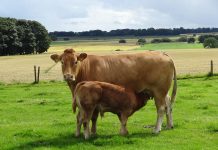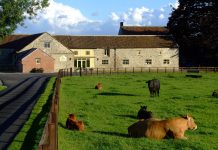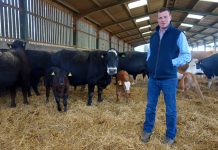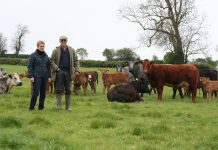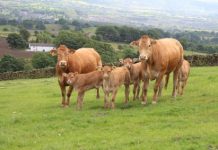Here we feature the 300 cow suckler herd, and ten strong Limousin bull battery, of the Sloan family’s Mull of Galloway Farm situated in the most southerly point of Scotland.
There are few Limousin cattle which enjoy life in such a spectacular setting as those on the Sloan family’s Mull of Galloway Farm near Stranraer, Dumfries & Galloway.
The farm is situated on the long, narrow peninsula which reaches to the most southerly point of Scotland and from where on a clear day, the story goes, you can see six Kingdoms – Scotland, England, Wales, Northern Ireland, The Isle of Man and Heaven!
Harvey, his wife Angela and his parents, Billy and Morag moved to the farm in 1993 when they were forced out of their fourth generation Ayrshire farm by a compulsory purchase order from the Coal Board, but they have never regretted the move, despite the remoteness of the new farm.
Three miles long and narrow, the farm runs to 600 acres plus about 50 acres of rough grazing on the cliff tops. The Sloans grow 120 acres of spring barley and oats which are crimped and clamped for cattle feed and cut 160 acres for silage twice. They also rent a further 170 acres of grazing from a neighbour.
Stocking consists of 300 suckler cows running with ten Limousin bulls and 530 Scotch Mule and Texel cross ewes.
 The herd used to be split spring and autumn calving but Harvey is currently trying to tighten the calving period to March, April and May, so he has bought in some extra dairy cross heifers and will cull some of the later calving cows later this year.
The herd used to be split spring and autumn calving but Harvey is currently trying to tighten the calving period to March, April and May, so he has bought in some extra dairy cross heifers and will cull some of the later calving cows later this year.
He said, “Although we keep our best heifers for replacements, I like to keep a bit of dairy blood in the herd for the milk and buy in a few Friesian cross heifers from trusted sources each year.” All incomers are tested for BVD even if they come from accredited herds and he only buys from Johnes tested farms.
Harvey also said he prefers to source his home-bred replacement heifers from older cows as he believes longevity is an important criteria and likes his cows to have at least seven calves. He said, “I try to avoid Holstein blood in any of the bought-in replacements for this reason.”
He only uses high index bulls with EBV beef values of over 40. Glenrock Highwayman by Sympa was bought privately from the Illingworth’s and with a beef value of +46 has left some great calves but sadly has hurt his shoulder this spring. Over the last two years he has had three bulls do this and Harvey said, “I really look after the bulls over the winter and they are in good nick when they go out, however I am considering ways of giving the bulls more exercise over the winter to keep them fitter. I am not sure if it will make any difference or if I have just been unlucky.”
He bought Dinmore Fortune by Wilodge Fantastic for 7500gns at Carlisle in 2010 and said he puts a good shape on calves from the more dairy type of cows.
The first crop of calves from the 4800gns Rachels Hercules had just been born and it will be interesting to see how they progress as the bull has an impressive EBV of +50 and +104 for 400 day weight.
Just out with cows for the first time are two Whinfellpark bulls bought at Carlisle in February. One is a son of the world record breaking 120,000gns Dolcorsllwyn Fabio, so Harvey is excited to see what kind of calves he will leave next year. He also purchased Reddings Ivan which is running with this year’s home-bred heifers. Harvey has worked with Reddings bulls in the past with some success and feels that they are reared in a way which suits his system.
The Mull of Galloway system is all about efficiency of production revolving round finishing cattle at target weights in the shortest time possible on a cost efficient feed system. The cattle are all electronically tagged and Angela is building up a database with a good picture of cows and their progeny showing how they are performing. Apart from recording growth rates, the data can be used to identify bloodlines for desirable traits such as longevity, growth rates and good feet and ultimately to select replacement heifers.
This has all been made easier this year with a new purpose-built finishing shed designed by Harvey and built mostly by him and his father. Harvey said, “I have always enjoyed drawing and design and my Dad is a great welder so we have built the vast majority of the steading ourselves also making all our own feed barriers and gates.” When they arrived at the farm 22 years ago there were just a couple of sheds, now there is housing for all the cows, a lambing shed, a finishing shed and various covered and uncovered silage pits; a total of 13 buildings all designed and built by the Sloans.
The new shed, which was just completed in November for the weaned calves to come into, is split into pens, each of which holds 16 15 month-old cattle, and more when they are younger. They are on cushioned slats which keep their feet right, saves a small fortune on straw and the cattle are remarkably clean for a slatted system. The cattle crush and handling system, complete with foot bath, weigh cell and tag reading technology is at one end of the shed and is designed to be operated by one man with only one other needed to move the cattle round.
 From weaning they are fed a total mixed ration (TMR) of mostly home-grown products. By the time they are 15 months they are on 3.5kg crimped barley, 1kg molasses, 2.5kg Vitagold and 1kg Harbro 25% blend per head per day plus silage. They also get Harbro Rumitech, a mineral supplement containing yeast which helps feed conversion.
From weaning they are fed a total mixed ration (TMR) of mostly home-grown products. By the time they are 15 months they are on 3.5kg crimped barley, 1kg molasses, 2.5kg Vitagold and 1kg Harbro 25% blend per head per day plus silage. They also get Harbro Rumitech, a mineral supplement containing yeast which helps feed conversion.
Through the weigh crate Harvey can see the daily weight gains which averaged 1.2kg per head from January to March. This worked out at a cost of £1 per kg live weight, however he reckons it will have improved since then to around 1.4kg daily live weight gain. He said, “I used to turn the calves out for a second summer but last year I kept some bullocks in to finish and they almost doubled the weight gain from May to September from 95kg to 180kg, so from now on they will be kept in the new shed with an aim of finishing them between 17 and 19 months.”
At about 15 months, the best heifers are siphoned off and put to the bull while the rest of the heifers are finished at 340 to 360kg deadweight and the bullocks 380 to 400kg. They are all sold to Stoddart’s at Ayr. Last year 70% of the bullocks and almost as many heifers made U grade with the best returning £2.70 per day according to Stoddart’s weigh line returns.
The key to making money from beef production, according to Harvey is to either finish them heavier or quicker by getting everything right from genetics to housing and feeding. He is delighted with the performance of the Limousin and, after dabbling briefly in other breeds back in Ayrshire said that he would not be tempted by anything else. He said, “Limousin bulls have good libido and the calves have great shape and are easy finished, since starting using them we have never looked back.”
The cows are in-wintered on a diet of silage and they receive some molasses and Vitagold when they calve. Although the Mull of Galloway is in the gulf stream and enjoys a mild climate, there can be some very cold, windy days so the cows are not turned out until May as the ewes and lambs keep on top of the early grass.
Cattle and sheep are grazed together as Harvey believes they complement each other and prevent a build-up of worms.
The sheep enterprise comprises of Scotch Mule ewes which are put to the Texel with some of the progeny retained and crossed with the Suffolk. They lamb inside in February and go straight out to grass with the first of the lambs sold in early May. The majority are away off grass by mid-June and this year by the first week in June, Harvey had sold 560 lambs. Those which meet the 21kg deadweight specification are sold to Woodhead Brothers and the heavier lambs go through the ring at Ayr or Castle Douglas.
Harvey said, “Out of a recent batch of 320 lambs which went to Woodheads, 104 were E grade and 200 U grade, although the price is back by about £30 per head this year.”
Another enterprise undertaken by the busy Sloan family is an award-winning cafe situated atop the spectacular cliffs at the southernmost point of their farm. The grass-roofed Gallie Craig Coffee House is so called after the rock which signifies the most southerly point of Scotland and last year celebrated its tenth year in business.
Harvey said, “We used to watch car after car driving down to the point but there was nothing there for all these tourists, so we applied to open a coffee shop and now we have between 30,000 and 40,000 visitors every year.”
Gallie Craig is run by Angela with three full-time and several part-time staff, while daughters, Sarah (20), and Gemma (18) help out in the holidays. Son, Bryce (14) enjoys helping out on the farm.
Angela said, “Because of the sensitivity of the site, it took a long time to get planning permission, but once we did, Harvey and Billy did most of the work with the help of my family who are builders. We were delighted when, a few years, ago we received a ‘commended’ in the Dynamic Places Green Award.” She went on, “It came as a complete surprise but that year, Harvey was also awarded ‘Individual of the Year.'”
It would certainly not be a surprise to anyone who is prepared to take the time to travel to this beautiful part of Scotland and see the inspiration and work which has gone into both the farm and the cafe to make them both successful enterprises in their own right and the Limousin breed has played a big part in this.








